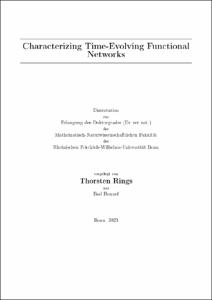Characterizing Time-Evolving Functional Networks

Characterizing Time-Evolving Functional Networks

| dc.contributor.advisor | Lehnertz, Klaus | |
| dc.contributor.author | Rings, Thorsten | |
| dc.date.accessioned | 2024-01-10T08:28:40Z | |
| dc.date.available | 2024-01-10T08:28:40Z | |
| dc.date.issued | 10.01.2024 | |
| dc.identifier.uri | https://hdl.handle.net/20.500.11811/11231 | |
| dc.description.abstract | Understanding spatially-extended, complex dynamical systems is a vital task in the natural sciences. From the climate over eco-socio-cultural systems to the human brain, time-evolving complex systems abound. These systems can exhibit various dynamical phenomena, some of which are only partially understood and can drastically and disastrously affect all areas of life - from climate change over a loss of resilience of ecosystems to other extreme events like epileptic seizures. Typically exceeding our ability to comprehend in total due to the their sheer complexity, a powerful tool to understand these systems is the functional network ansatz. With this ansatz, a system is reduced to a network of interacting elementary units. Here, network vertices are associated with sampled units and network edges represent interactions between the units. In case interactions can not be assessed directly, one resorts to characterizing properties of interactions from recordings of the units' dynamics employing multivariate time series analysis techniques in a time-resolved manner. Then, the time-evolving functional networks can be investigated in lieu of the original complex dynamical system and assessed with network characteristics from graph theory on different scales - from the global scale encompassing the whole network to the local scale of single network constituents (vertices and edges). Relationships between the various time-evolving characteristics and the dynamics of the underlying system - both its emergent global dynamics as well as the dynamics of its elementary units -, however, are not yet fully understood. With this thesis, we set out to improve our understanding of such relationships. We critically assess the functional network ansatz and its assumptions and identify confounding variables in order to evaluate the approach's suitability for field data analysis. To this end, we investigate paradigmatic model systems with well-known constraints as well as a complex natural system, the human brain. We provide novel insights into the rich interplay between structural organization, dynamics and functional relationships in these systems. Of note, local but not global network characteristics, that describe structural organization, robustly indicated the emergent global system dynamics, including the generation of extreme events. Regarding the latter, we developed a non-perturbative, data-driven approach to evaluate a system's stability against endogenous and exogenous perturbations by aggregating edge characteristics, thereby providing a proxy for the system's resilience. Notwithstanding these advancements, the problem of bridging various spatial and temporal scales in a time-evolving functional networks remains. Nevertheless, an improved understanding of complex systems and their dynamics can be achieved with the functional network approach, whose full potential is yet to be exhausted. | en |
| dc.language.iso | eng | |
| dc.rights | In Copyright | |
| dc.rights.uri | http://rightsstatements.org/vocab/InC/1.0/ | |
| dc.subject | dynamische Systeme | |
| dc.subject | komplexe Systeme | |
| dc.subject | Zeitreihenanalyse | |
| dc.subject | komplexe Netzwerke | |
| dc.subject | nichtlineare Phänomene | |
| dc.subject | dynamical systems | |
| dc.subject | complex systems | |
| dc.subject | time series analysis | |
| dc.subject | complex networks | |
| dc.subject | nonlinear phenomena | |
| dc.subject.ddc | 530 Physik | |
| dc.title | Characterizing Time-Evolving Functional Networks | |
| dc.type | Dissertation oder Habilitation | |
| dc.publisher.name | Universitäts- und Landesbibliothek Bonn | |
| dc.publisher.location | Bonn | |
| dc.rights.accessRights | openAccess | |
| dc.identifier.urn | https://nbn-resolving.org/urn:nbn:de:hbz:5-73870 | |
| dc.relation.doi | https://doi.org/10.1038/s41598-022-14397-2 | |
| dc.relation.doi | https://doi.org/10.1063/1.4962295 | |
| dc.relation.doi | https://doi.org/10.1140/epjst/e2017-70021-3 | |
| dc.relation.doi | https://doi.org/10.1038/s41598-019-47092-w | |
| dc.relation.doi | https://doi.org/10.1038/s41598-018-38372-y | |
| ulbbn.pubtype | Erstveröffentlichung | |
| ulbbnediss.affiliation.name | Rheinische Friedrich-Wilhelms-Universität Bonn | |
| ulbbnediss.affiliation.location | Bonn | |
| ulbbnediss.thesis.level | Dissertation | |
| ulbbnediss.dissID | 7387 | |
| ulbbnediss.date.accepted | 24.11.2023 | |
| ulbbnediss.institute | Mathematisch-Naturwissenschaftliche Fakultät : Fachgruppe Physik/Astronomie / Helmholtz-Institut für Strahlen- und Kernphysik (HISKP) | |
| ulbbnediss.fakultaet | Mathematisch-Naturwissenschaftliche Fakultät | |
| dc.contributor.coReferee | Bertoldi, Frank | |
| ulbbnediss.contributor.orcid | https://orcid.org/0000-0001-5097-4821 |
Files in this item
This item appears in the following Collection(s)
-
E-Dissertationen (4379)




